Our Products
Showing 85–94 of 94 results
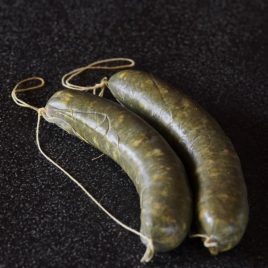
Green Chorizo
The Iberians have been on the trail of interesting and new smallgoods and we are loving the results. Inspired by the Los Angeles street taco scene Dez has been on the hunt for the secrets behind green chorizo’s, and it looks like he has found them. We have sourced a producer with the knowhow to create the vibrant Mexican green chorizo (Chorizo Verde). The specialty sausage originates from the area of Toluca, Mexico and is made from a combination of green chilli peppers, coriander, spinach, seeds and garlic to give the chorizo a very natural flavour that seasons the pork thoroughly with a spicy kick, but doesn't overpower the meat, creating a link with great flavour and balance.
This is a fresh take on the more traditional Spanish red chorizo and provides endless possibilities for your menu. Green chorizo is traditionally removed from its casing and used as a filling in tacos, but it has been reimagined by hundreds of chefs across the USA in its sausage form. It has been included as an element in seafood dishes and often as a breakfast item served with eggs. However, you decide it could be used on your menu, we know it will be a new addition to the Sydney and Melbourne dining scene.
Download our info sheet
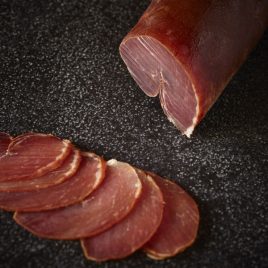
Lomo (Cured pork loin)
The lomo embuchado (pork loin) has its origin in Aragon (Spain), and is one of the cured meat products that have been protected under the Diputación de Aragón guarantee mark since 1993 in order to protect the quality of the product.
The preparation of the loin has been carried out in Aragon since ancient times. Originally the pork meat was obtained from the la matanza tradicional (traditional killings), now with the protection of the Diputación de Aragón guarantee mark ensures that the finest quality pork lion continues to be used as before.
The lomo embuchado of Aragon uses only the freshest meat free of the outer fat from castrated male pigs or females outside the estrus period, with salt and other natural spices marinated and then put into a sausage net. It is then allowed to mature for a maximum period of 60 days. The loin obtains an intense flavour, fine texture and is soft on the palate and is marketed with the seal of food quality. It comes in a ‘candle’ between 50 to 70 cm in length.
For their preparation, the loins are put to cure in salt and sugar for one or two days, then washed and left to air dry for a further two days until they are well drained. After the loin is marinated with a dressing prepared with paprika, garlic, oregano, and olive oil, they are put into elongated casings and hung for healing in a cool, dry environment for at least two to three months.
Its flavour is intense and natural, usually presented as a ‘candle’ or in thin slices cut vertically and vacuum packed, it then needs to be kept in a cool dry place. Its exterior colour is light and inside it has a dark vivid red colour with marble-like appearance, because of the fat that has infiltrated. The loin is consumed raw as it is a cured meat.
Tasting themes: Sliced thin in a crunchy baguette drizzled with a high-quality Spanish olive oil, in pinchos, on a charcuterie board.
Download our info sheet
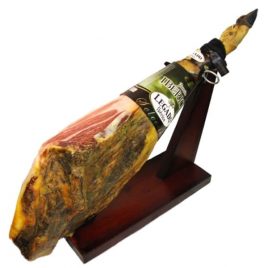
Iberico Ham
The black Iberian pig lives primarily in the central and southwestern region of the Iberian Peninsula, which includes both Portugal and Spain.
Immediately after weaning, the piglets are fattened on barley and maize for several weeks. The pigs are then allowed to roam in pasture and oak groves to feed naturally on grass, herbs, acorns, chestnuts, and roots, until the slaughtering time approaches. At that point, the diet may be strictly limited to olives, chestnuts or acorns for the best quality jamón ibérico, or may be a mix of acorns and commercial feed for lesser qualities.
The hams from the slaughtered pigs are salted and left to begin drying for two weeks, after which they are rinsed and left to dry for another four to six weeks. The curing process then takes at least twelve months, although some producers cure their jamones ibéricos for up to 48 months.
In particular, the ibérico hams from the towns of Guijuelo in the Salamanca province and Jabugo in the Huelva province have their own denominación de origen.
The hams are labelled according to the pigs' diet and the percentage of the pigs' Iberian ancestry, with an acorn diet and pure-bred Iberians being most desirable. The current labelling system, based on a series of color-coded labels, was phased in starting in January 2014.
- The finest is called jamón ibérico de bellota (acorn). This ham is from free-range pigs that roam oak forests (called dehesas) along the border between Spain and Portugal and eat only acorns during this last period
- The exercise and diet have a significant effect on the flavour of the meat; the ham is cured for 36 months. This grade is divided into black-label jamón 100% ibérico de bellota, produced from pure-bred Iberian pigs, and red-label jamón ibérico de bellota from free-range pigs that are not pure-bred.
- The next grade is called jamón ibérico cebo de campo. This ham is from pigs that are pastured and fed a combination of acorns and grain.
- The third type is called jamón ibérico de cebo, or simply, jamón ibérico it is cured for 24 months and is the most popular due to its cheaper prices and shorter curing time. This ham is from pigs that are fed only grain.
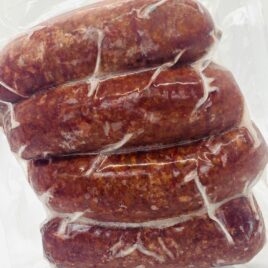
Morcilla (Spanish black rice pudding)
Morcilla (black pudding), a Spanish tradition that makes a fine tapa. Increasingly present in the modern kitchen for its exquisite taste and its versatility: in puff pastry, pies, scrambled, grilled or pan fried ... Always delicious!
There are two types Malagueña and Burgos the first being made with onion and the second with rice.
With the Malagueña (Southern) made with caramelized onion. Only the very large variety was selected, with its strong robust flavour and firm protective skin. Planted in the spring and pampered in the family garden, it was harvested in autumn with great yields, hanging in aerated branches in a dry place for its conservation.
The Burgos (Northern) supporting ingredient rice which is added lightly cooked at low temperature which infuses the spices into the grain. This morcilla can be eaten "raw" (since it is already cooked), or fried, roasted, or smoked.
It combines very well in rolls, pintxos or slow cooked with legumes (beans, lentils or chickpeas), making a stew not only a gastronomic delight but also a dish with great nutritional value.
Download our info sheet
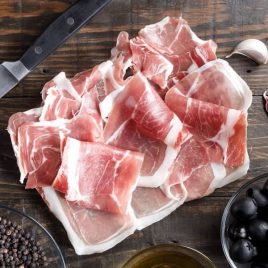
Serrano Ham
The majority of Serrano Jamones are made from a landrace breed of white pigs or from commercial breeds such as Duroc or Berkshire are not to be confused with the often more expensive jamón ibérico, made from black Iberian pigs.
These aged hams were known as a delicacy even in the days of the Roman Empire. The protein is of high quality and after curing for 12-14 months the meat becomes a rich intense red colour.
The serrano leg is always bigger than the Ibérico as it always contains less fat due to the different diets of each pig breed. Unlike the Italian prosciutto which is cured cold, the Spanish Jamones (ibérico & serrano) are cured in a specially ventilated room that mimics the conditions of the traditional cellar.
Jamón serrano can be used in a charcuterie board, in a bocadillo (crunchy bread roll), salad, stews, croquettes, pasta, pizza just about wherever your culinary imagination can take you.
Download our info sheet
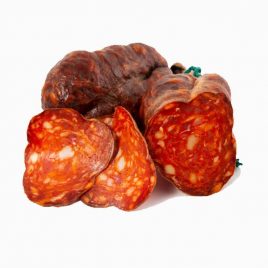
Morcón
Morcón is a type of chorizo, eaten in much the same way. The difference is the meat with which it is made, which is usually lean without much fat content, and that the meat is stuffed into a section of pork large intestine.
The marinade used to flavor the chorizo is mainly composed of paprika, garlic, and salt. Due to the thickness of the sausage, the maturity period is quite long.
It is typical of some regions in Spain such as Andalucía, Salamanca, and Extremadura.
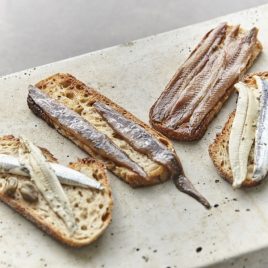
Pickled seafood
The boquerons (marinated anchovies) NASSARI are elaborated from the best prime material,obtained from our seas. Boquerons NASSARI is a fish that has been fished in the Mediterranean Sea, North Atlantic and the Cantabrian sea. They are produced by firstly being cleaned in abundant water, then marinated with wine vinegar and salt, this is how they obtain their characteristic flavour, colour and texture.
Product cleaned one by one, by hand.
The anchovy (Engraulis Encrasicolus) is obtained from the larger of the species, through a process inherited from the ancient Romans, salting. A gastronomic product of high quality, valued for it's characteristic aroma, obtained from a long process of salting. Throughout the salting process, the fish's own blood and a long process of curing, gives it it's own characteristic aroma. The anchovy is carefully filleted, and each fillet checked one by one to guarantee the quality of the product.
The anchovy (Engraulis Encrasicolus) is obtained from the larger of the species, through a process inherited from the ancient Romans, salting. A gastronomic product of high quality, valued for it's characteristic aroma, obtained from a long process of salting. Throughout the salting process, the fish's own blood and a long process of curing, gives it it's own characteristic aroma. The anchovy is carefully filleted, and each fillet checked one by one to guarantee the quality of the product.
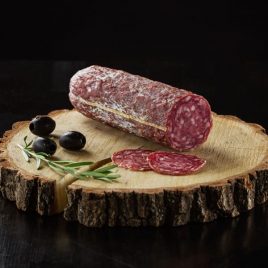
Salchichón (Hot, Mild, Truffle)
The salchichón popularly known as the wider longaniza is similar to the Spanish salami and has its origins in Greek and Roman times. These days it has gained a reputation as an appetizer, cut with a knife, accompanied by a quality tostada (toasted bread) and a good Spanish wine - this is very typical of the provenance of Barcelona, the capital of this particular sausage.
Salchichon de Vic is popular throughout the country and with its history, tradition and quality is easily recognised as a product of the lands of Osona region.
If we go a little deeper into history, we discover that Salchichon de Vic was mentioned for the first time in a 14th Century document found in the Episcopal Archives of Vic. Its fame spread throughout the late 19th Century when his Majesty Alfonso XII, King of Spain, when visiting the city of Vic made three visits - one to visit the Bishop, the other to go to the Cathedral and the third, to visit the sausage factory.
In order to achieve the characteristic flavour, the formula for its production has been maintained, imitating the work of the farmers of the Plana de Vic. They have since ancient times picked the best lean meat and fat from the pig marinating with garlic, salt and black pepper then hung in the cellar to cure. The pig breeds most used for their production of Salchichon de Vic are Berkshire, Large white and Duroc.
The Iberians have not wanted to lose the unmistakable flavor of traditional Spanish sausages and, over the years, have remained true to the classic recipes and processes. Through their careful attention to detail, artisanal process and dedication to the craft The Iberians produce one of the most authentic range of cured Spanish sausage in Australia.
A tasting theme: This product can easily replace any dish that contains Italian salami and in Catalonia it is used in salads, baguettes, tostadas with rubbed ripped tomato and on popular charcuterie board.
Download our info sheet

Sobrasada
Sobrasada is a traditional soft cured sausage from Mallorca made with ground pork, paprika, salt and spices, and it is the national sausage of the Balearic Islands. At The Iberians we start with premium quality free-range pork add a pinch of sea salt and sun dried paprika from De la Vera (DOP), the result is a finely textured Sobrasada of excellent quality.
It is traditionally shaped as a Salchichón, and wider than a chorizo. It is unique for its soft-spreadable texture.
A remarkable dish from the Balearic Islands is the Sobrasada omelette with ‘rubbed’ tomato on toast.
Sobrasada is usually served spread on crusty bread with Mahon cheese and toasted until it melts, there is no other sausage from Mallorca more typical than this except for the butifarró.
Sobrasada is a versatile sausage and can also be used as a filling in pasta dishes, on pizza or fried with sea food or meat and even as part of a honey-based sauce making it one of the most versatile products of all Spanish cured meats. This is a gluten free product.
Download our info sheet
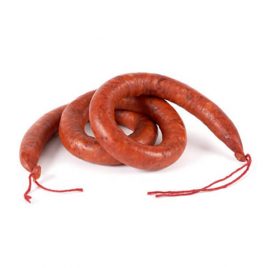
Txistorra (Pork belly chorizo)
To speak of the origin of the chistorra (txistorra) is to speak of the Navarre region in Spain. This rich sausage has a characteristic reddish colour and smoky paprika flavor and is made from a mixture of craft skills and history. The txistorra popular in a main meal or as an appetizer or snack.
It has been a tradition since ancient times pig farming has allowed many families and cities in Spain and its autonomous regions to obtain quality proteins and this is where the origin of chistorra comes from.
The txistorra or chistorra comes from the Basque term longaniza. It is a sausage of Basque-Navarrese and Aragonese origin. It is made with fresh minced pork meat, garlic, salt, aromatic herbs such as parsley and a good amount of paprika this gives it it’s characteristic colour and flavour.
Traditionally in Spain and as with today’s gourmet products every part of the butchered animal is used. In Guipúzcoa, due to climatic and or economic reasons, the pork slaughter was carried out shortly before the arrival of winter. In some localities like Lodosa in the Basque country the txistorra is usually made with the meat and lung of the pig.
In the Aragones and Navarra region of the Pyrenees the txistorra is made only with the pork meat. In Jaca’s Fields they have another variety made from the liver, and other remains of the pig, which is called arbiello, a word in Aragonese that means esophagus, since it is where the ingredients are stuffed.
In the province of León, the Chistorra de León is prepared, and is made with greater quantities of beef. Nowadays it is usually sold fresh, but increasingly you can buy it vacuum packed in a spiral shape in any of the Spanish supermarkets.
The txistorra has a characteristic flavour is very tasty and high in fat. It is usually eaten fried or roasted and is usually served as a midday dish in Madrid with "broken eggs and potatoes".
Tasting themes: Fried with apple cider and served with quality crusty bread, grilled whole in its spiral shape, in pinchos or with t fried broken eggs on top of roasted potatoes.
Download our info sheet

